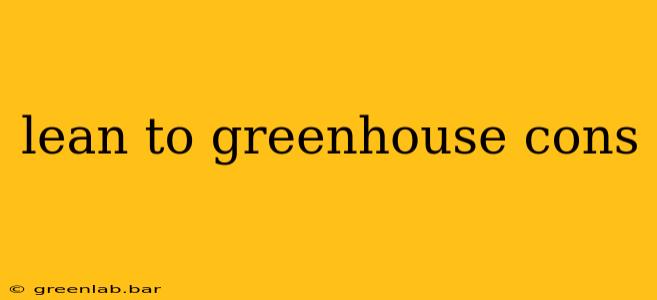Lean-to greenhouses offer a simple, affordable, and often aesthetically pleasing way to extend your growing season. However, before you rush into construction, it's crucial to understand the potential drawbacks. This article will explore the cons of lean-to greenhouses, helping you make an informed decision about whether this type of structure is right for your needs.
Limited Space and Functionality
One of the most significant disadvantages of a lean-to greenhouse is its limited space. The design, by nature, restricts the growing area to the available wall space. This can severely limit the number and types of plants you can grow, especially if your existing structure is small. You might find yourself constantly battling for space and struggling to accommodate taller plants or those requiring significant root systems.
Furthermore, the single-slope design often doesn't offer the optimal interior layout for efficient gardening. You might find it challenging to organize your plants logically, leading to inefficient use of space and potentially hindering air circulation.
Light Limitations
While sunlight is crucial for plant growth, the single-sloped design of a lean-to greenhouse can create light limitations. The angle of the roof will determine how much direct sunlight your plants receive, particularly during the winter months when the sun's angle is lower. The side facing away from the sun will also receive significantly less light, impacting plant growth in that area. This might necessitate supplemental lighting, adding to the initial cost and ongoing maintenance.
Temperature Fluctuations
Lean-to greenhouses are often more susceptible to temperature fluctuations compared to freestanding greenhouses. The attached wall can act as a heat sink, causing temperature drops at night, especially if the wall material is not well-insulated. Similarly, during the day, the wall can absorb and radiate heat, potentially overheating the greenhouse. Maintaining a consistent temperature becomes more challenging and might require more sophisticated temperature control systems.
Potential for Structural Issues
Depending on the construction of your existing structure and the lean-to's design, there's a potential for structural issues. Adding a lean-to can put extra stress on the existing walls and foundation, potentially leading to cracks or other damage if not properly engineered and supported. Incorrectly constructed lean-to greenhouses can be prone to collapse, particularly in areas with heavy snow or strong winds. Professional assessment is crucial before proceeding with construction.
Integration Challenges
Integrating a lean-to greenhouse seamlessly with your existing building can be a challenge. You might need to consider factors like roof pitch, wall material, and overall aesthetics to ensure the lean-to blends well with your home or other structure. A poorly integrated lean-to can detract from the overall appearance of your property.
Conclusion
Lean-to greenhouses offer several advantages, but these drawbacks should be carefully considered. Thorough planning, including professional consultation on structural integrity and light analysis, is essential to mitigate these potential problems. Carefully weigh the pros and cons to determine if a lean-to greenhouse is the right solution for your gardening needs and existing structure. Understanding these limitations will help you make a well-informed decision and avoid costly mistakes.

